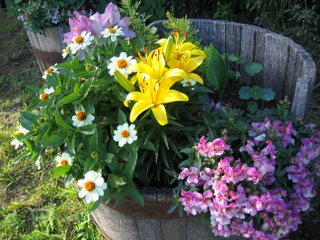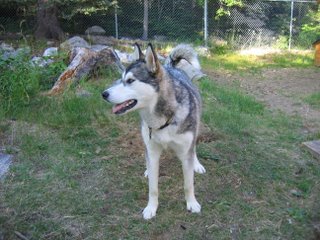The boreal forest behind our house in northern Saskatchewan is home to a great crop of wild berries this year. I really should quit my job to become a berry picker for the next few weeks. Or maybe we can buy some berries from the Besnard Lake correctional institution again this year, where the inmates pick berries and sell them. No, they don't set up a fruit stand or anything, but I think we had connections with someone who worked there.

"The Bush" behind our house is made up of trees, shrubs, small plants, and lichens growing over and between large slabs of granite. These plants like acid soil, living in peaty organic material that builds up under the thick spongy layer of moss that grows atop the rock slabs.
 |
| June 5 photo - blossoms of American cranberry, aka Viburnum trilobum |
Berries in our area: Edible and not-so-edible
 |
| Lingonberry, locally known as "Cranberries" |
Lingonberries, otherwise known as
dry-ground cranberries (Vaccinium vitis-idaea). These plants and berries are really tiny, much smaller than the commercial cranberries seen growing on the Oceanspray cranberry farms. They are good in baking and make a great cranberry sauce to go with poultry.
Lingonberries: They have dry white flesh with dark seeds around the center. They are tart and crisp, but not especially juicy. If you live here and are lucky, you may find bags of these for sale at Robertson's store. Online information about these berries can be found
here.
 |
| Lingonberry, cut open |
 |
| Bunchberry, a variety of dogwood |
Bunchberries (
Cornus canadensis), the tiniest plant of the dogwood family. These berries are apparently edible according to
this source from
the University of Alberta. I found that a bit suprising, because most
dogwood berries are identified as poisonous. They taste bad and
probably don't make a good jam.
Common Bearberry (
Arctostaphylos uva-ursi) is a little less numerous than the lingonberries. In my opinion, these are not edible. However, they have been eaten and there are claims for medicinal use.
 |
| Bearberries |
Wikipedia includes this in its description:
"Bearberry is relatively safe, although large doses may cause nausea, green urine, bluish-grey skin, vomiting, fever, chills, severe back pain, ringing in the ears (some people can withstand up to 20g and others show signs of poisoning after just 1g); take no more than 7-10 days at a time." I guess this berry falls somewhere between "deadly poisonous" and "foods to eat if starvation is your other option".
 |
| Bearberries, cut open |
Though the plants look similar, the bearberries are easily distinguished from the cranberries by the smooth bottom of the berry, with only the solitary central dimple and little point that can easily be rubbed off. Cranberries have a ring at the bottom, with a little "crown" similar to that of blueberries.
Bearberries cut open. They are dry and pulpy.
 |
| Wild blueberries |
Blueberries. These are smaller and sweeter than the commercial berries from the larger type of blueberry plants. None of these plants are taller than 12 inches (30 cm). They are extremely nutritious and are amazing cooked in pancakes. Of course, I eat those pancakes with maple syrup from our eastern Canadian maple trees!
Pincherry (
Prunus pensylvanica)
trees are a common wild tree here. Our yard is full of them. The fruits are quite tart and the central pit is large relative to the size of the fruit. The wild pincherries are vital for pollination of my Carmine jewel tart cherries.
 |
| Pincherries |
 |
| Northern Comandra (red berries) |
Northern Comandra, aka "Northern Bastard Toadflax", Geocaulum lividum: Found growing around many rocky areas around La Ronge. Its foliage is bronze in fall, which is distinct from the other berry plants. The berries are orange-red and soft and juicy. They have a non-bitter flavour, though references call its edibility "questionable". It apparently is parasitic on the roots of other plants, and it appears this one might be parasitic on the adjacent blueberry. Parts of the plant had been used in traditional medicines.
 |
| Northern Comandra cut open berry |
Cut-open berry. They were the juiciest of the berries I cut open.
 |
| Red Baneberry |
Red Baneberry (Actaea rubra) is a perennial plant that grows very attractive berries in clusters held on upright stems. I saw this one on July 27, 2012 near Nistowiak Falls. All parts of this plant are
poisonous, so please don't eat the berries! The branch with its underside visible to the right of the berry is the foliage of this plant.
Other common berries in northern Saskatchewan:
- See my post on some other berries.
- Saskatoon berries
- Wild black currants
- Wild raspberries
- "Cranberry" (Viburnum) -- blooms pictured near the top of this post
 Garbagicus neglecticum var. beverageilis
Garbagicus neglecticum var. beverageilis, yet another non-edible of the north. Distribution: worldwide. Considered a non-attractive invasive species. Often associated with lazy
Homo sapiens who have no respect for the earth or other people's property.

Yesterday, I baked
muffins with my own poppy seed, including frozen wild blueberries instead of the raspberries listed in this
recipe from epicurious. They were delicate and delicious.
 |
| Poppy seed heads |
Resident-lawnmower-man and I picked nearly one litre of poppy seeds from my flower bed. He's a good farmboy that can't see anything go to waste, so we'll either be seeding half the town in poppies or eating delicious poppyseed baking for months.
Wild roses are sporting bright red rosehips now. These are packed with vitamin C, though I haven't made any plans on making them into any foodstuffs at the moment.
 |
| Rosehips on Wild Rose Bushes |
I also made a delicious swiss chard and parmesan pie last night. I found the recipe online
here. I'd never grown swiss chard before, so the dish and the plant were both new for me. This quiche-like tart was quite similar to a spinach pie, with a more mild flavour. Kids and adults alike would love this dish. Resident-lawnmower-man was rather skeptical until he tasted the final product. He now admits that swiss chard is not only made for rabbits.
 |
| Precise edibiles-detecting tool: |
 |
| "Why can't I go berry picking?". |












 Garbagicus neglecticum var. beverageilis, yet another non-edible of the north. Distribution: worldwide. Considered a non-attractive invasive species. Often associated with lazy Homo sapiens who have no respect for the earth or other people's property.
Garbagicus neglecticum var. beverageilis, yet another non-edible of the north. Distribution: worldwide. Considered a non-attractive invasive species. Often associated with lazy Homo sapiens who have no respect for the earth or other people's property.  Yesterday, I baked muffins with my own poppy seed, including frozen wild blueberries instead of the raspberries listed in this recipe from epicurious. They were delicate and delicious.
Yesterday, I baked muffins with my own poppy seed, including frozen wild blueberries instead of the raspberries listed in this recipe from epicurious. They were delicate and delicious.








